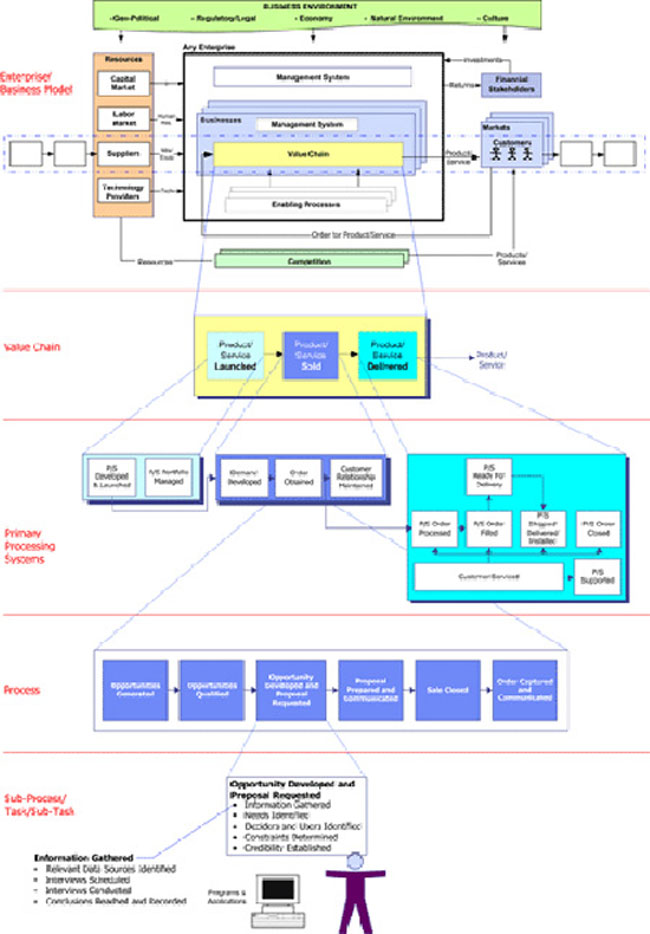Inside organizations that are doing various kinds of process “work”-whether improvement projects, technology enhancements or process definition and documentation—we often hear a lot of confusion and frustration because people sometimes mean different things when they use the word “process.” The most common frustration happens when two people are talking at different “levels” of process—with one person perhaps talking about a big end-to-end process such as order fulfillment while the other person is talking about a single task but one with multiple steps and considerable complexity—yet both are
Inside organizations that are doing various kinds of process “work”-whether improvement projects, technology enhancements or process definition and documentation—we often hear a lot of confusion and frustration because people sometimes mean different things when they use the word “process.” The most common frustration happens when two people are talking at different “levels” of process—with one person perhaps talking about a big end-to-end process such as order fulfillment while the other person is talking about a single task but one with multiple steps and considerable complexity—yet both are using the term “process”. The problem gets even worse when whole segments of an organization adopt one interpretation of “process” versus the general understanding within the organization, and well-intentioned initiatives are frequently undermined when tools are applied at an inappropriate level. For example, we have frequently seen six sigma practitioners at odds with others where management expects large-scale improvement of the important value-creation processes such as product development, or selling and marketing, yet the six sigma folks are focused on detailed measurement and improvement of sub-processes at a micro level.
At The Performance Design Lab, our approach to resolving this confusion is to offer people a Processing System Hierarchy and help them to sort out what they mean by process and to have them identify which levels are relevant to their use of the term.

Figure 1 is a Hierarchy consisting of six levels. At the top is the entire organization as a system, with all of the processes and functional areas depicted in the context of its marketplace, its resources and competitors, and the general environment in which the organization must operate. Most of the time, people are not referring to this topmost level when they talk about processes, but what this model suggests is that every organization is in fact a giant processing system, and all of its individual processes are contained somewhere in this system, and sometimes improvement is required at this level, when an organization has to overhaul its entire way of doing business.
Level 2 is a depiction of the organization’s value chain, which is the means by which the organization creates, sells and delivers products and services of value to the marketplace. The value-chain level is kind of a mega-process view, and in a large, complex company there may be multiple value chains for different products and services. Sometimes people who talk about process do mean the entire value chain, and quite often improvement is needed at this level, when parts of the value chain are misaligned or missing.
Level 3 then divides the components of the value chain into three general types of processes, what we call the Available, Sold and Delivered processes.
Available includes those processes–such as research, product development, and product extensions—whose purpose is to create new products and services. Sold includes those processes that are aimed at marketing and selling the goods and services. And Delivered includes those many processes that get the products and services to customers and provide on-going support. At this level, we are still talking about multiple sets, or bundles, of processes.
It’s at Level 4 that we reach the individual process level, and it will be one of those processes contained inside Available, Sold or Delivered. Often this is the level of process that people mean when they talk about “end-to-end” processes, because these processes typically begin with a market or customer input (an order, a product idea) and end with an output that either goes to the customer or becomes an input to another stage of the value chain. For example, the output of the product development process in Available is a new product that now can be marketed and sold by those employees who participate in the Sold processes. The other processes to be found at this level are management processes and enabling processes (for example, the hiring process or the technology development process).
One important point: Even if we are invited into an organization that has already focused on Level 4 processes, we always advise them to go back up to define and understand at least Level 3 and maybe higher. Our approach is macro to micro, making sure we understand the context of performance at a broad level before diving deeper.
Level 5 then decomposes a given process into sub-processes and tasks. It’s at this level that the performer (whether human or technology or a combination) becomes visible. And Level 6 goes into even greater detail, delving into sub-steps and procedures. Sometimes people who use the word “process” are actually talking about Level 5 or even 6, because from their vantage point, what they do is a whole process, although from the Process Hierarchy view, they are well down in the weeds within a single sub-process or even a single task.
It is important to get agreement of what level of process is appropriate for various kinds of process improvement or definition work before launching the effort. For example, if an organization decides it wants to document its current processes (let’s say in order to meet Sarbanes-Oxley compliance requirements), at what level should the documentation take place? Should it be at Level 4, which would mean mapping the big processes of the organization at a fairly high level, or should it be at Level 5, which would mean dozens of sub-process maps and hundreds of steps and tasks, or does it have to be at Level 6, the procedural level, in order to meet the compliance standards? What hinges on the decision is the amount of effort that will be required—a Level 4 documentation effort may take weeks, while a Level 5 effort could take many months and many resources—and what level of detail is sufficient to meet the objective.
In guiding organizations while they make decisions like this, we try to first help everyone understand and adopt the same mental model of processes, which the Process Hierarchy helps us to achieve. Then we try to guide them in making a good decision about which level we should be working at for a given effort, and it is not always at the most excruciating level possible.

















